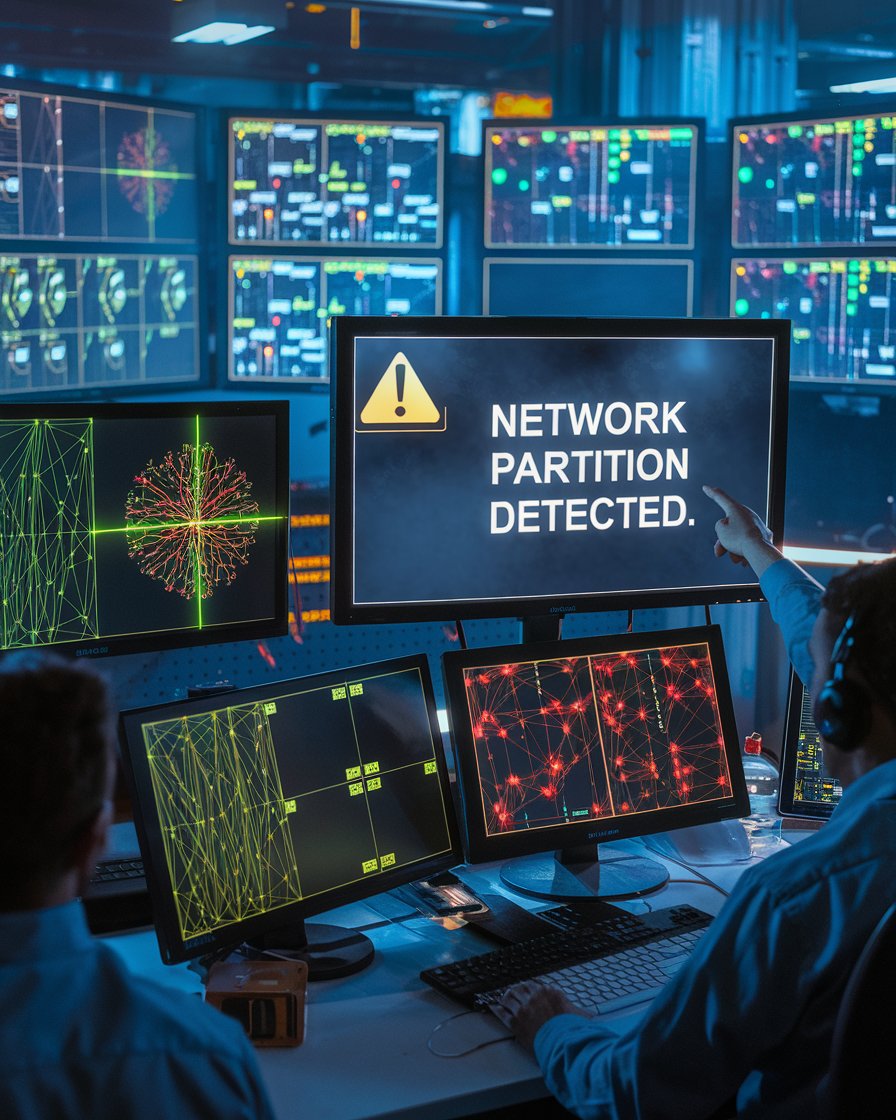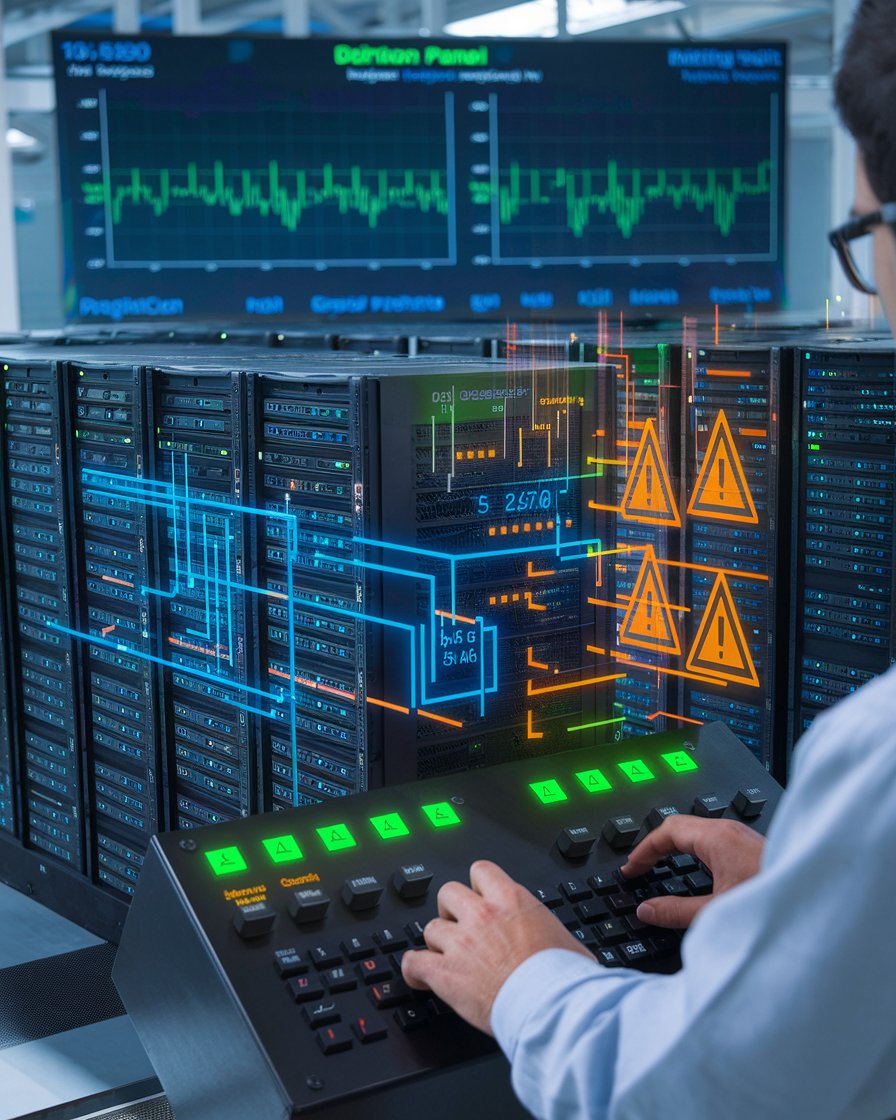Introduction
When dealing with network partitions, especially in distributed systems, it’s essential to ensure both the availability and consistency of data. Network partitions, also known as split-brain scenarios, happen when a cluster of nodes is split into two or more isolated groups. This isolation affects communication between nodes, requiring the system to detect and handle the partition effectively. The system must ensure that even during these events, transactions are processed without compromising the overall network. Protocols designed to detect these partitions ensure that the system remains functional by managing the communication and operation of nodes during the partition event.
One of the biggest challenges is maintaining data consistency when partitions occur. A general overview of the CAP theorem highlights the trade-offs between consistency, availability, and partition tolerance in these cases. Each partition must operate independently, and methods like quorum-based replication and leader elections ensure that one partition can process new data without creating inconsistencies. When the partitions rejoin, protocols must simulate the merging of data securely to prevent any loss or stale information across nodes.
Key Takeaways
- Detecting network partitions requires protocols that ensure system operation and manage split-brain scenarios by maintaining communication between isolated nodes.
- Partition handling in distributed systems involves replication and leader election techniques to maintain data consistency across isolated partitions.
- The CAP theorem highlights the trade-offs between availability, consistency, and partition tolerance during network failures.
- Handling split-brain scenarios focuses on mitigating data inconsistencies by allowing only one partition to accept new transactions.
- Secure data handling protocols ensure data remains encrypted and protected even when network partitions occur, preventing unauthorized access.
- When rejoining partitions, the system must synchronize data across nodes, ensuring no stale or outdated information is merged.
Detecting Network Partition: Protocols and Split-Brain Handling
Network partitions, also known as split-brain scenarios, occur when nodes in a cluster are isolated from each other due to network failures. To detect such partitions, protocols are implemented to ensure the system remains operational. In the event of a network partition, the cluster must determine if the partition is temporary or long-lasting. Detection protocols check whether nodes can still communicate or if they need to execute partition handling methods. These protocols must handle transactions and ensure availability while maintaining data consistency. Ensuring that nodes detect partitions quickly helps prevent data inconsistencies and secure overall system performance.
Key Strategies for Handling Cluster Network Partition Like a Split Brain
-
Implementing Quorum-Based Replication A critical strategy in mitigating the effects of a cluster network partition is the use of quorum-based replication. This ensures that only the majority of nodes within one partition are allowed to process new transactions, avoiding split-brain scenarios where both partitions attempt to make independent decisions. By electing a quorum leader, the system maintains consistency and avoids data corruption.
-
Using Consensus Algorithms to Prevent Split-Brain Scenarios Consensus algorithms such as Paxos or Raft are essential in managing network partitions. These algorithms ensure that all nodes agree on the current state of the system, preventing conflicting data states across partitions. These protocols help elect a new leader and restore system synchronization when connectivity is re-established, reducing the impact of a split-brain.
-
Data Encryption and Secure Communication Across Partitions During a split-brain, it’s important that the system continues to operate securely. Encrypting data transmission between nodes ensures that sensitive information is protected even if communication between partitions becomes unreliable. This strategy helps maintain data security until normal operations resume, preventing unauthorized access during network partition events.
-
Periodic Monitoring and Health Checks Regular health checks and monitoring of the network are vital to detecting partitions early and responding quickly. Proactive monitoring tools can identify degraded performance or potential network failures, enabling the system to initiate partition handling methods before serious issues arise. Early detection allows for smoother recovery when the partition is resolved.
-
Optimizing System to Handle Large-Scale Partition Events Network partitions can become more challenging as the system scales. Optimizing the system for high availability and partition tolerance ensures that even under high workload, the system remains operational. Techniques like redundant data storage across partitions and distributing the workload effectively help in managing large-scale failures while minimizing disruptions.
Key Protocols for Partition Detection in Distributed Systems
In distributed systems, detecting network partitions involves several key protocols that help maintain system availability and prevent inconsistencies. These protocols focus on identifying when nodes become isolated and implementing mechanisms to ensure that both sides of a partition can continue to function. Network protocols detect whether a split-brain situation has occurred and initiate partition handling procedures. The system needs to ensure data consistency while still processing transactions during the partition. This helps operators manage network partition events effectively, minimizing the impact on node availability.
Handling Split-Brain Scenarios: Mitigating Data Inconsistencies
During split-brain scenarios, one of the primary challenges is mitigating data inconsistencies across partitions. Handling these events requires protocols that secure data within each partition and ensure that only one of the partitions can accept new transactions. Algorithms are put in place to resolve the split-brain situation, electing a new leader from the majority of nodes, ensuring that stale data doesn’t compromise the system. These solutions help ensure that once the network is restored, data re-synchronization can occur seamlessly across all nodes, preventing potential data loss.
Implementing Partition Handling in a Distributed System
Partition handling in distributed systems is a critical factor in maintaining node availability. When network partitions occur, the system must implement methods to ensure that at least one partition remains operational. This involves algorithms that degrade functionality gracefully, allowing nodes to continue processing data. In a network partition scenario, operators can rely on replication techniques to keep data consistent across isolated nodes. The system’s ability to handle partitions ensures resilience in times of network failure, with nodes rejoining the cluster once connectivity is restored. This helps manage workloads without compromising overall system performance.
Case Study: How LinkedIn Tackled Cluster Network Partition with Quorum-Based Replication
LinkedIn, a huge online network, faced some big challenges when their cluster network partitioned, especially when traffic spiked. They needed to keep things running even when parts of their network got cut off. To solve this, LinkedIn used quorum-based replication. This method allowed one side of the network partition to still process transactions while making sure the smaller side stayed inactive to avoid split-brain scenarios. Their use of consensus algorithms kept everything in sync, even when parts of the system were disconnected.
On top of that, LinkedIn set up constant monitoring to catch network problems early. This helped stop issues from snowballing into bigger failures. Once the network reconnected, LinkedIn’s data replication system merged all the data smoothly, without losing anything. This strategy shows how important it is to have good partition handling and replication in place when you’re dealing with distributed systems, especially when you’ve got a lot of users counting on you.
Strategies for Resilience During Network Partitions
Resilience during network partitions is critical in distributed systems, and several strategies can be implemented to ensure minimal service disruption. These strategies involve partition handling algorithms that allow nodes to continue processing tasks within their respective partitions. By replicating data across the nodes in both partitions, the system can maintain consistency, even when connectivity is lost. Operators must also consider the possibility of degraded performance and optimize system settings to prioritize essential tasks. This ensures the system remains available for reads and writes without compromising data integrity.
Replication Techniques to Ensure Data Consistency Across Partitions
Data replication is key to ensuring consistency across network partitions. When a partition occurs, replication techniques enable nodes to continue operating independently by maintaining a local copy of the data. This approach ensures that the system can handle larger-scale failures without losing valuable information. Techniques like quorum-based replication and leader election help maintain order across partitions. Once the network is restored, the replicated data is merged, and inconsistencies are resolved. These techniques are crucial in maintaining high availability and ensuring that distributed systems can withstand partition events.
Limitations of Network Partition Detection: A Comprehensive Look
Despite advances in detection protocols, there are limitations when it comes to identifying network partitions effectively. The challenge lies in maintaining data consistency and availability when nodes are split across partitions. The CAP theorem highlights the trade-offs between availability, consistency, and partition tolerance in these systems. Even with majority voting or quorum-based approaches, inconsistencies may arise if a split-brain scenario persists for too long. The protocol’s reliance on the majority of nodes in one partition can lead to stale data or delayed recovery. Understanding these limitations helps operators implement better solutions for handling network failures.
Trade-offs Between Availability, Consistency, and Partition Tolerance
The CAP theorem outlines the fundamental trade-offs between availability, consistency, and partition tolerance in distributed systems. During a network partition, ensuring availability means that some degree of consistency may be sacrificed. Similarly, striving for perfect consistency can reduce the system’s availability. Operators must carefully balance these factors when detecting and handling partitions. Network topology and the number of nodes also influence how well the system can tolerate partitions without compromising overall performance. Understanding these trade-offs helps in designing systems that can better handle network failures.
Challenges of Maintaining Data Consistency in Split-Brain Scenarios
Maintaining data consistency during split-brain scenarios presents significant challenges. The primary issue is ensuring that only one partition can process new transactions while preventing the other partition from accepting inconsistent writes. Techniques like leader election and quorum-based replication are used to control this, but in cases where partitions persist for extended periods, data inconsistencies can still occur. Operators must monitor these partitions closely and ensure that the system can rejoin nodes and synchronize data without introducing stale or incorrect information into the dataset.
“Perfection is achieved, not when there is nothing more to add, but when there is nothing left to take away.” – Antoine de Saint-Exupéry
Secure Data in the Event of a Split-Brain Network Partition
When a split-brain partition occurs, ensuring data security becomes a top priority. Nodes in each partition must operate independently while maintaining data encryption and correctness. One partition may get isolated, but it should still process data securely. Implementing partition handling protocols ensures that even during failure, data remains secure and available for reads. Systems must be designed to handle these events while optimizing for secure data storage. As nodes rejoin, ensuring that no stale data is introduced into the system is crucial for maintaining integrity across the entire network.
Encryption and Data Security During Network Partitions
In the event of a network partition, ensuring that data remains secure is of utmost importance. Encryption techniques are applied to secure data within each partition, making sure that even if nodes are isolated, data integrity is maintained. Secure data handling protocols ensure that any transactions that occur during the partition are properly encrypted, preventing unauthorized access. This approach also helps in the rejoining phase, ensuring that sensitive data is not compromised when the partitions merge and nodes resume normal operations.
Rejoining Partitions: Ensuring No Data Loss or Stale Information
When network partitions are resolved, ensuring that no data is lost or corrupted is critical. During the rejoining process, the system must verify that all data across partitions is synchronized and consistent. Partition handling protocols carefully check for stale information before re-adding nodes into the active cluster. This process involves analyzing the data from both partitions, prioritizing the most recent and correct information to avoid merging any outdated data. Ensuring that nodes in one partition match the data from the other side helps maintain overall system accuracy.
Conclusion
In conclusion, managing network partitions in distributed systems is a complex but essential process to maintain availability and data consistency. The system must rely on robust protocols to detect split-brain scenarios and implement partition handling methods, ensuring that nodes can continue operating independently during network failures. Techniques like quorum-based replication and leader election are critical for keeping data consistent across isolated partitions, minimizing the risk of inconsistencies and stale information.
When rejoining partitions, it’s vital that data from both sides is synchronized to prevent data loss or corruption. Secure data handling, such as encryption, ensures that sensitive information is protected during network failures and reconnection phases. By maintaining a balance between availability, consistency, and partition tolerance, distributed systems can effectively manage large-scale networks, even in the event of network partition failures. Properly designed systems ensure minimal disruption and optimal performance.













